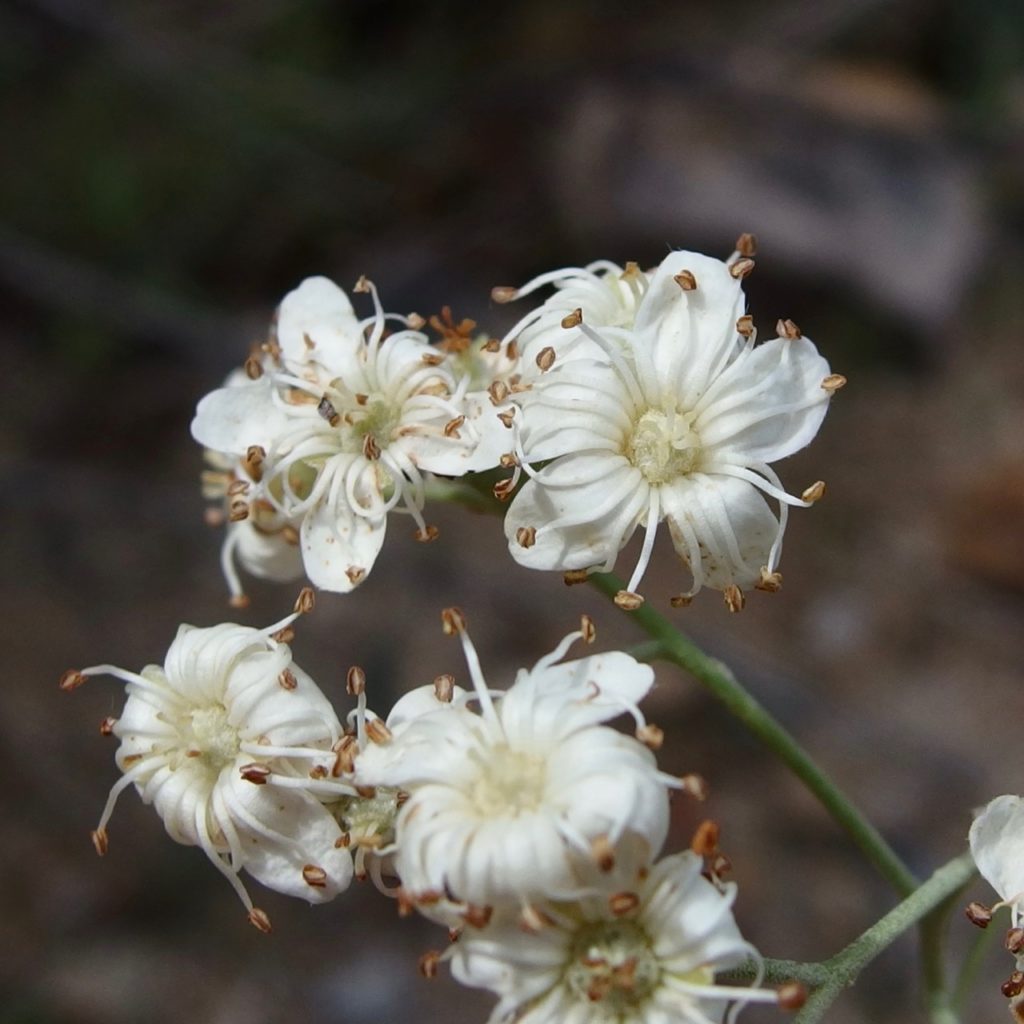Scientific name: Vauquelinia californica (Torr.) Sarg.
Common name: wild crabapple
Family: Rosaceae (rose)
Life form: Perennial, small tree/large shrub
Bloom time: May-July
Article by Eva Maria Räpple
Vauquelinia is a genus of broadleaf evergreen shrubs or small trees native to the arid and semi-arid lands of the Southwestern United States and Mexico. The genus Vauquelinia was established by Humboldt and Bonpland (1807) in their Plantae Aequinoctiales, given in honor of the chemist Louis Nicholas Vauquelin (1763-1829). The subspecies Vauquelinia californica grows from Arizona, New Mexico, and southwestern Texas south to Durango, Baja California, and Coahuila, Mexico, between 2,500 to 5,000 feet elevation. Vauquelinia californica can be found in high desert and low oak woodland regions up into the lower piñon-juniper zones in mountainous areas. Growing along dry slopes in midst of oak woodland and grass desert landscapes, the Arizona rosewood is connected through an astounding web of mycorrhizal fungi vital to the longevity of arid ecosystems.

Vauquelinia californica growing in Arizona, Santa Cruz, Tumacacori Mountains near Tumacacori Peak. Photo: Sue Carnahan. Published by: SEINet Portal Network (accessed through the SEINet Portal Network Portal, https://swbiodiversity.org/seinet, 2024-12-23). CC BY-NC 3.0
Although slow growing, given the right conditions Arizona rosewood can become a small tree over time reaching up to 10-25 feet tall with a multiple-stemmed trunk. The wood is dark brown with thin, scaly red/brown bark, more gray when older. The leaves are narrowly lance-shaped (long and pointed), between 2-4 in wide with saw-toothed edges, medium green on top and hairy underneath. Its many beautiful dense clusters of tiny white flowers at tips of the branches emerge between April and June. These cymes are from two to three inches across and attract especially bees and butterflies. The fruit, a hard capsule with two seeded parts, remains on the branches throughout the winter. Birds love the dense branches as nesting habitat.

Vauquelinia californica flowers. Photo: Sue Carnahan. Published by: SEINet Portal Network (accessed through the SEINet Portal Network Portal, https://swbiodiversity.org/seinet, 2024-12-23). CC BY-NC 3.0

Vauquelinia californica leaves. Photo: L.R. Landrum. Published by: SEINet Portal Network (accessed through the SEINet Portal Network Portal, https://swbiodiversity.org/seinet, 2024-12-23). CC BY-NC 3.0
The Arizona rosewood is especially prized by Southwestern gardeners as a valuable heat-tolerant evergreen that can be used as an ornamental specimen plant or privacy hedge, offering shelter from harsh winds or establishing distinct spaces. The slow-growing shrub offers an excellent choice for dry, sandy soils although it can benefit from deep supplemental irrigation once a month. Adaptability to temperature ranges also makes the shrubs or trees excellent additions to streets or along highways, offering colorful accents and habitat for pollinators and birds. The wood is quite heavy, hard, and attractive but has not been used widely for woodwork or other usage because of the slow growth of the shrub and the relatively small size and rarity of the tree.

Photo: Sue Carnahan. Published by: SEINet Portal Network (accessed through the SEINet Portal Network Portal, https://swbiodiversity.org/seinet, 2024-12-23). CC BY-NC 3.0
Although certainly well adapted to the lower, warmer altitudes in New Mexico, it is important to find the right microclimate when considering planting Vauquelinia californica in Santa Fe, where a location with sunny exposure, relatively sheltered and protected from cold winds will be beneficial to its growth. Seek out the Arizona rosewood above the meadow in the Santa Fe Botanical Garden, where we are trialing two plants (donated by Lauren Springer 2024) to see if it can thrive at 7,200 feet.
References:
Bloss, H. E., and C. Walker. “Some Endogonaceous Mycorrhizal Fungi of the Santa Catalina Mountains in Arizona.” Mycologia 79, no. 4 (1987): 649–54. https://doi.org/10.2307/3807610.
Elbert L. Little, JR. A Guide to the Native Species of New Mexico and Arizona. Agriculture Handbook No. 9. United States Department of Agriculture. 1968. pp. 55-56.
Hess, W. J., and James Henrickson. “A Taxonomic Revision of Vauquelinia (Rosaceae).” SIDA, Contributions to Botany 12, no. 1 (1987): 101–63. http://www.jstor.org/stable/23909854.
Lady Bird Johnson Plant Database. “Vauquelinia californica (Torr.) Sarg.” University of Texas at Austin. https://www.wildflower.org/
Wingate, Marty. “Uncommon Hedges.” Landscape Architecture 96, no. 12 (2006): 68–73. http://www.jstor.org/stable/44675714.


